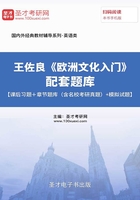
第3章 中世纪时代
Questions for revision:
1What happened in Western Europe after the decline of the Roman Empire?
【答案】After the Roman Empire lost its predominance, a great many Germanic Kingdoms began to grow into the nations know as England, France, Italy, and Germany in its place. These nations of Western Europe were in the scene of frequent wars and invasions. The political unity had given way to widespread destruction and confusion. Hunger and disease killed many lives and village fell into ruin and great areas of land lay waste. There was no central government to keep the order. The only organization that seemed to unite Europe was the Christian church. Christianity was almost the all and the one of Medieval lives in western Europe and took lead in politics, law, art, and learning for hundreds years.
2What were the cultural characteristics of the period from 500 to 1007.
【答案】Above all, the cultural characters of this period were the heritage and achievement of Roman culture and the emergence of Hebrew and Gothic culture.
3Who was Charles Martel?
【答案】Charles Martel was a Frankish ruler who gave his soldiers estates known as fiefs as a reward for their services in 732.
4What was the relationship between lord and vassal?
【答案】Lords granted parts of their lands known as fiefs to vassals. In return, the vassals promised to fight for the lords.
5Into what three groups were people divided under feudalism?
【答案】Under feudalism, people of their Western Europe were mainly divided into three classes: clergy, lords, and peasants.
6What was the difference between a serf and a free man?
【答案】A serf had no land and no freedom. He was bond to the land where he had been born. A free man was a peasant who usually was a worker who made the ploughs, shod the horses, and made harnesses for oxen and horses.
7What is the importance of the using of vernacular languages in Medieval literature?
【答案】In the Middle Ages, some “national epics” were written in vernacular language—the language of various national states that came into being at that period, and some monks advocated translating the Bible in vernacular. Literary works were no longer all written in Latin. It was the starting point of a gradual transition of European literature from Latin culture that was the combination of a variety of national characteristics.
8In what ways did Gothic art differ from Romanesque art?
【答案】(1) Although Gothic was an outgrowth of the Romanesque, it was given directions by a different aesthetic and philosophical spirit and reflected a much more ordered feudal society with full confidence.
(2) Romanesque architecture is characterized by massiveness, solidity, and monumentality with an overall blocky appearance. Sculpture and painting, primary in churches, developed a wonderful unity with architecture. Both arts often are imbued with symbolism and allegory. They are not based on natural forms but use deliberate distortions for expressive impact.
(3) Gothic cathedrals soared high, their windows, arched and towers reaching heavenward, flinging their passion against the sky. They were decorated with beautiful stained glass windows and sculptures more lifelike than any since ancient Rome.
9What was the merit which Charlemagne and Alfred the Great share?
【答案】Both Charlemagne and Alfred the Great contributed greatly to the European culture. Both of them encouraged learning by setting up monastery schools. The scholars in Alfred the Great’s monasteries translated the Latin works into the vernacular. Thus both helped preserve the ancient classics and culture.